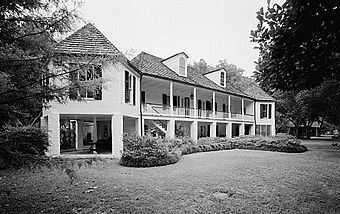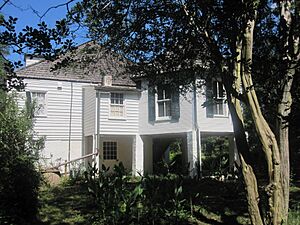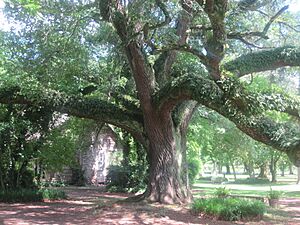Melrose Plantation facts for kids
|
Melrose Plantation
|
|

Melrose Plantation
|
|
| Location | LA 119 off LA 493, Melrose, Louisiana, U.S. |
|---|---|
| Architectural style | Colonial |
| NRHP reference No. | 72000556 |
Quick facts for kids Significant dates |
|
| Added to NRHP | June 13, 1972 |
| Designated NHLD | May 30, 1974 |
Melrose Plantation, also known as Yucca Plantation, is a special historical place in Melrose, Louisiana. It is recognized as a National Historic Landmark. This plantation is unique because it was one of the largest in the United States built by and for free people of color.
The land was given to Louis Metoyer, who started building the main house, called the "Big House," around 1832. Louis was the son of Marie Thérèse Coincoin, a former slave who became a successful businesswoman. His father was Claude Thomas Pierre Métoyer, a French military gentleman.
Louis's son, Jean Baptiste Louis Metoyer, finished the "Big House" in 1833 after his father passed away. The Metoyer family were free people of color for four generations before the American Civil War. Even though they were free, they also owned slaves, which was common for large plantations at that time.
Today, the Association for Preservation of Historic Natchitoches owns Melrose Plantation. They offer guided tours so visitors can learn about its history. Since the 1970s, new research has helped us understand more about the plantation's past. For example, we now know more about its first owners and the style of its buildings.
In 2001, archaeologists began digging at the site. Their work has uncovered even more clues about the early days of Melrose Plantation. In 2008, Melrose Plantation became one of the first 26 places on the Louisiana African American Heritage Trail. This trail highlights important sites related to African American history in Louisiana.
Contents
The History of Melrose Plantation
In 1974, the National Park Service described Melrose Plantation based on what was known then. They believed it was started in the late 1700s by Marie Therese Coincoin. They also thought some buildings, like the Africa House, might have been designed with direct African influences.
The plantation has several important buildings. These include the main house, the Yucca House, the Ghana House, and the Africa House. There are also other smaller buildings. Melrose Plantation was officially named a National Historic Landmark in 1974.
New Discoveries About the Plantation
Since the 1970s, historians have found more information that changed some earlier ideas. For example, research showed that Marie Therese Coincoin was not the first owner of the land. Also, there is no proof that the property was ever called Yucca Plantation in its early days.
The names of some buildings, like Ghana House and Africa House, were given by owners in the early 1900s. They did this to promote the plantation as a cultural center. A study in 2002 found that the architecture of these buildings does not show African traditions. The Ghana House is a simple log cabin, like many others in the area. The Africa House uses building styles similar to French country homes from that time.
Who Really Owned the Land?
New historical studies and archaeological digs starting in 2001 have helped confirm some old stories and correct others. Records show that the main part of the land, about 911 acres, was given to Louis Metoyer in 1796. He was Marie Therese Coincoin's second son.
Louis and his brothers and sisters were called "Créoles of color" because they had a French-American father and an African mother. Many multiracial Creoles became educated and owned property. This was especially true in places like New Orleans and the Cane River area. Louis Metoyer was not legally freed by his white father until 1802. He was able to own land even though laws at the time usually stopped enslaved men from doing so. This was likely because of his father's wealth and standing in the community.
Early Buildings and Important Family Members
Earlier ideas suggested Louis Metoyer's first home, the Yucca House, was built in the mid-1790s. However, land surveys from 1813 show his home was south of the Red River. This was at the edge of the plantation owned by his older brother, Augustin Metoyer. Archaeological findings suggest the Yucca House was first used after 1810.
Augustin and Louis Metoyer were important figures in their community. They helped found and build the St. Augustine Parish (Isle Brevelle) Church in Natchez, Louisiana. This was the first church in the state built by free people of color.
Melrose Plantation is important because the Metoyer family lived there for a long time. They were a well-known family in Isle Brevelle, a strong community of "Creoles of color."
Changes in Ownership
Construction on the "Big House" at Melrose began before Louis Metoyer passed away in 1832. His son, Jean Baptiste Louis Metoyer, finished building it in 1833. When J. B. L. Metoyer died in 1838, his estate was divided. His young widow and their son, who was still a minor, inherited it. They did not have much experience with money matters.
After a financial downturn, the mother and son got into a lot of debt. The Louis Metoyer Plantation was eventually sold at an auction. In 1847, the plantation was bought by two French Creole brothers, Hypolite and Henry Hertzog. Henry was acting for his sister, Jeanne Fanny Bossier.
The Hertzogs and Bossier ran the plantation as a cotton farm until 1880. Like many plantation owners after the American Civil War and Reconstruction, they faced financial challenges. They were not able to do much to improve or keep up the property.
In 1881, the plantation was sold again at auction to pay off debts. The new owner, F. R. Cauranneau, lived elsewhere. In 1884, he sold the property to Joseph Henry, an Irish immigrant merchant. Joseph Henry named the property Melrose, which is still its name today.
Later Occupancy and Importance
Studies of items found at the Yucca House site show three main periods when people lived there. These were around 1807–1821, 1874-1888 (after Joseph Henry bought it), and 1916-1930 (when Henry's son John and his wife Carmelite "Miss Cammie" Henry lived there). This research helped correct earlier ideas about when the Yucca House was first used.
Melrose Plantation is a key site for understanding the history of Creoles of color in the region. This is because of its strong connection to the Metoyer family. In 2008, it was included as one of the first sites on the Louisiana African American Heritage Trail.
Images for kids
-
Clementine Hunter House
-
Nearby Cane River Lake
See also














